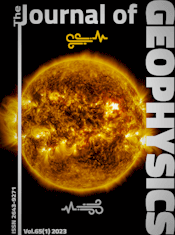Energetics of the Earth's core
Article Sidebar

Vols. 1-18 (1924-1944), ISSN 0044-2801
Main Article Content
Abstract
The energy supplied to generate the Earth's magnetic field must ultimately result in heat flowing across the core-mantle boundary and through the Earth's surface. If the liquid core is stirred by thermal convection then only a small fraction of the total heat is dissipated in the electric currents, and in order to explain the observed field at least 1011 watt and probably 1013 watt of the Earth's surface heat flux must originate deep inside the core. If the core is cooling and there is concomitant chemical differentiation, a large amount of gravitational energy is released. This energy, unlike the heat released, is completely dissipated in the electric currents and enables the same magnetic field to be generated with a much lower heat flux. Chemical differentiation is therefore favoured as the energy source for the dynamo. The importance of gravitational settling depends on the density jump at the inner core boundary and on the stratification parameter in the outer core, both of which can, in principle, be determined seismologically.
 ARK: https://n2t.net/ark:/88439/y027224
ARK: https://n2t.net/ark:/88439/y027224
Permalink: https://geophysicsjournal.com/article/64
Article Details
References
Braginsky, S.I. (1964) Magnetohydrodynamics of the Earth's core. Geomagn. Aeron. 4:698-712
Busse, F.H. (1970) Thermal instabilities in rapidly rotating systems. J. Fluid Mech. 44:441-466
Chapman, D.S., Pollack, H.N. (1975) Global heat flow: A new look. Earth Planet. Sci. Lett. 28:23-32
Gilbert, F., Dziewonski, A.M. (1975) An application of normal mode theory to the retrieval of structural parameters and source mechanisms from seismic sources. Phil. Trans. Roy. Soc. London A, 278:187-269
Gubbins, D. (1976) Observational constraints on the generation process of the Earth's magnetic field. Geophys. J. 47:19-39
Hewitt, J.M., McKenzie, D.P., Weiss, N.O. (1975) Dissipative heating in convective flows. J. Fluid Mech. 68:721-738
Landau, L.D., Lifshitz, E.M. (1959) Fluid mechanics. 536 pp. London: Pergamon
Lapwood, E.R. (1952) The effect of contraction in the cooling by conduction of a gravitating sphere, with special reference to the Earth. Mon. Not. R. Astr. Soc. Geophys. Supp. 6:402-407
Malvern, L.E. (1969) Introduction to the mechanics of a continuous medium, 713 p. Englewood Cliffs, New Jersey: Prentice Hall
Verhoogen, J. (1961) Heat balance of the Earth's Core. Geophys. J. 4:276-281
Williams, D.L., von Herzen,.R.P. (1974) Heat loss from the Earth: new estimate. Geology 2:327-328











